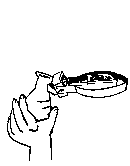SynFlo is a new project that began this semester in an effort to further explore the role of technology within the domain of synthetic biology. This tangible user interface seeks to convey basic synthetic biology concepts to a diverse audience of children and families in an informal science learning setting. SynFlo mimics a wet-lab protocol used in a real synthetic biology experiment. It uses small micro-computers (Sifteo Cubes) with dynamic actuation and display capabilities, which are mounted onto 3D-printed labware such as petri dishes and beakers. The project team is advised by Prof. Orit Shaer and consists of Evan Segreto ’15, Casey Grote ’14, and Johanna Okerlund ’14, in collaboration with Anja Scholze and Romie Littrell from San Jose’s Tech Museum of Innovation.
SynFlo was originally conceived as an outreach project for iGEM 2012 as an interactive installation that walks participants in an outreach science program through the basic steps of E. chromi: an experiment conducted by the University of Cambridge iGEM team, involving the creation of E. coli that serve as color-changing biosensors. The installation consisted of three main parts: a triplet of Sifteo cubes, a triplet of tangibles, and the Microsoft Surface. The Sifteo cubes represented the genes, plasmid, and E. coli, respectively; the tangibles represented the toxins; and the Surface acted as an environment in which to deploy the engineered bacteria. Users progressed through a simulation of the E. chromi experiment as they would in the wet lab.
First, users choose the gene to be used in the experiment, by tilting the cube to scroll and pressing to select. Then, the gene is inserted into the plasmid, which acts as the vehicle for insertion into the E. coli. Users do this by neighboring the gene and plasmid cubes and shaking, simulating a vortex mixer. Finally, the plasmid is inserted into the E. coli by neighboring the plasmid and bacteria cubes. Users can then test their creation by deploying the bacteria within the Microsoft Surface and adding various toxins.

A user floods the environment with a yellow (lead) toxin by touching the tangible to the Surface.
More information regarding this first version of SynFlo can be found here.
The second iteration of SynFlo began in late January as a collaborative effort between the Wellesley HCI Lab and the San Jose Tech Museum of Innovation, after we were contacted by two members of the Tech’s research team, Romie and Anja. They were looking for extant examples of interactive applications to teach children basic synthetic biology concepts and happened to stumble across documentation of the version described above. In collaboration with Romie and Anja, we began work on implementing a new version of SynFlo–one that would work on the new Sifteo SDK (2.0) and would incorporate more tangible elements. The most recent version of the application, with which we ran preliminary user studies with visitors at the Tech, looks like this:
We tested two different implementations of SynFlo: (1) Sifteo cubes alone (which is similar to the original SynFlo implementation) and (2) Combining Sifteo cubes with 3D-printed tangibles and labware. Thus, there are two ways to interact with the system for each step of the experiment.
STEP 1. Users select their desired gene. This step does not differ much between versions–in one, users select the tangible representation of their gene, and in the other, users select the Sifteo cube containing the digital representation of their gene.
STEP 2. Users insert the gene into an empty plasmid. In the labware version, they insert the DNA strand into the plasmid beaker. In the other, users simply neighbor the gene and plasmid cubes. In both versions, users shake the gene and plasmid to simulate vortexing.
STEP 3. Users insert the plasmid into the E. coli.The labware version requires users to “pour” the plasmid into a petri dish containing the E. coli. Similar to the step above, users neighbor the cubes in the cube-only version.
STEP 4. Users test their E. coli. Using the labware, users “pour” beakers of toxin into the petri dish to introduce the substance to the E. coli’s environment. Using the cubes alone, users neighbor toxin cubes with the E. coli cube to test for a reaction.
In general, we found that large tangibles help to attract users–the labware drew people over in a way we didn’t see when working with just the Sifteo Cubes. Visitors also spent more time engaged with the tangible version and seemed to remember the process, often repeating it for all the available genes. On average, users who interacted with the tangible representations spent 6.3 minutes engaging with the system: 2.6 minutes more than the 3.7 minutes spent on the cubes alone. Visitors who were watching (and not interacting directly) seemed to find the tangibles more interesting as well, spending more time engaged with watching than with the cubes only. Perhaps most importantly, we asked several children which version they would prefer, and they all indicated a preference for the tangible representations, saying that they made the interaction better, using words like “fun” and “interesting”.
Although the semester is coming to a close, we have big plans for the future of SynFlo. Evan Segreto is presenting a poster on the project at the Wellesley College Computer Science Department’s annual Senior Poster Session. This summer, with our new iGEM 2015 team co-instructed by Orit, Romie, and Anja, we’ll be exploring the interaction space of the Multitaction Surface to supplement our existing tangible prototype and to develop new interactive experiences for communicating synthetic biology to the general public.



